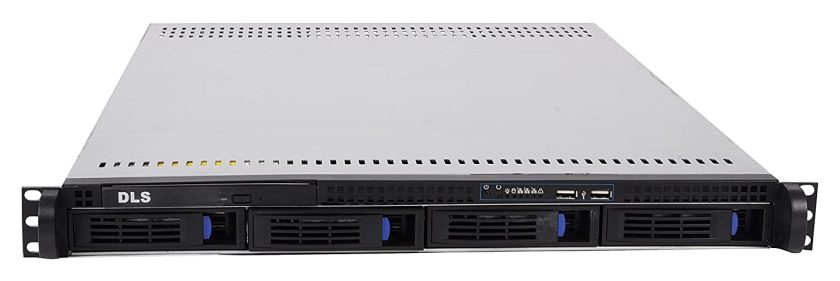What is a blade server?
A blade server is a compact, modular server architecture that allows multiple server modules, called blades, to be housed within a shared enclosure known as a blade chassis. Each blade functions as an independent server, with its own CPU, memory, storage, and network connectivity.
The blade chassis provides a centralized power supply, cooling system, and management infrastructure for the blades. It typically includes features like redundant power supplies and fans to ensure high availability and fault tolerance. The chassis also integrates networking switches and other components to facilitate communication between the blades and external networks.
Blade servers offer several advantages over traditional rack-mounted servers:
Space efficiency:
Blade servers significantly reduce physical space requirements compared to individual rack-mounted servers. Multiple blades can be densely packed within a single enclosure, saving valuable data center floor space.
Simplified management:
The centralized nature of blade server architecture simplifies server management tasks. Administrators can easily monitor and manage all the blades in the chassis from a single interface, reducing complexity and streamlining operations.
Scalability:
Blade servers offer excellent scalability. As business needs grow, additional blades can be added to the chassis without requiring significant modifications to power, cooling, or networking infrastructure.
Power and cooling efficiency:
Blade servers typically incorporate efficient power supplies and cooling mechanisms shared across multiple blades. This results in better energy efficiency, reduced power consumption, and lower cooling requirements compared to individual servers.
Modular design:
Blade servers are designed for modularity, allowing for easy upgrades and maintenance. Blades can be quickly inserted or removed from the chassis without disrupting the operation of other blades.
Blade servers are commonly used in data centers and enterprise environments where high-density computing, manageability, and scalability are crucial requirements. They are well-suited for virtualization, cloud computing, and resource-intensive applications that demand efficient use of space and power resources.
Blade Servers’ Benefits for Data Centres
Blade servers offer several advantages in data center environments, making them a popular choice for many organizations. Here are some key advantages of blade servers:
Space Efficiency:
Blade servers are designed to maximize space utilization in data centers. By consolidating multiple server modules into a single chassis, they significantly reduce the physical footprint required compared to traditional rack-mounted servers. This space efficiency allows data centers to accommodate a larger number of servers in a smaller area, effectively increasing the computing power within a limited space.
Scalability:
Blade servers provide excellent scalability options. Data centers can easily scale their computing resources by adding or removing blades from the blade chassis without the need for significant infrastructure modifications. This modular design allows for rapid expansion or contraction of server capacity, providing flexibility to adapt to changing business needs.
Simplified Management:
Blade servers streamline server management tasks. The shared infrastructure within the blade chassis, such as power supplies, cooling systems, and networking components, simplifies maintenance and administration. Management interfaces and software tools allow administrators to monitor and manage multiple blades centrally, reducing complexity and easing operational overhead.
Energy Efficiency:
Blade servers are engineered to be energy-efficient. The consolidated power supplies and cooling systems in the blade chassis result in improved power utilization and reduced energy consumption compared to individual servers. By eliminating redundant power supplies and cooling fans found in traditional rack-mounted servers, blade servers help lower electricity costs and contribute to greener data center operations.
High Density and Compute Density:
Blade servers enable high-density computing by packing a large number of server modules into a compact enclosure. This density maximization allows data centers to achieve higher processing power and computational capacity per space unit. Blade servers are particularly beneficial for applications that require significant computational resources, such as virtualization, high-performance computing (HPC), and data analytics.
Centralized Networking:
Blade servers often incorporate integrated networking switches within the blade chassis. This centralized networking infrastructure simplifies network connectivity and reduces cable clutter, making it easier to manage and configure network connections for multiple servers. Consolidated networking also improves network performance and reduces latency by minimizing interconnect distances.
Cost Savings:
Blade servers can result in cost savings over time. While the initial investment may be higher due to the chassis and infrastructure requirements, the overall total cost of ownership (TCO) can be lower. Blade servers reduce ongoing expenses related to power consumption, cooling, rack space, cabling, and management, leading to potential cost savings in the long run.
Blade servers have become a preferred choice for data centers seeking efficient, scalable, and manageable computing solutions. However, it’s important to consider factors such as workload requirements, infrastructure compatibility, and vendor support before implementing blade server technology in a specific data center environment.
UserBlade Server Architecture
Blade server architecture refers to the design and structure of blade servers, which are compact, modular computing systems that combine multiple server modules (blades) within a shared enclosure called a blade chassis. Here are the key components and aspects of blade server architecture:
Blade Chassis:
The blade chassis serves as the physical enclosure that houses the blade servers. It provides power distribution, cooling, and networking infrastructure for the blades. The chassis typically includes a backplane, which acts as a high-speed communication pathway between the blades and other components.
Blade Modules:
Blade servers are comprised of individual server modules known as blades. Each blade is a self-contained server unit with its own CPU, memory, storage, network interfaces, and other components. Blades are designed to be hot-swappable, allowing for easy insertion and removal from the chassis without disrupting the operation of other blades.
Shared Infrastructure:
Blade servers share common infrastructure resources within the chassis. This includes power supplies, cooling fans, networking switches, and management interfaces. By consolidating these resources, blade servers optimize space utilization and simplify management tasks.
Management Module:
Blade server architectures incorporate a management module that provides centralized management and control of the blades. This module typically includes a dedicated management processor, firmware, and interfaces for monitoring and configuring the blades. It allows administrators to remotely manage the blades, monitor hardware health, and perform tasks such as firmware updates and provisioning.
Networking Infrastructure:
Blade server architectures often include integrated networking switches within the blade chassis. These switches facilitate network connectivity between the blades, external networks, and storage systems. The networking infrastructure within the chassis simplifies cabling, reduces latency, and improves network performance.
Power Distribution:
The blade chassis features a power distribution unit (PDU) that distributes power to the blades. The power supplies within the chassis are typically redundant and hot-swappable, ensuring high availability and fault tolerance. Blade servers often incorporate power management features, allowing administrators to monitor power consumption and allocate power resources efficiently.
Cooling System:
Blade server architectures employ cooling mechanisms to maintain optimal operating temperatures within the chassis. The chassis contains cooling fans or blowers that ensure adequate airflow and heat dissipation. The efficient cooling design is crucial for managing high-density computing environments and preventing thermal issues.
Interconnectivity and Backplane:
Blade servers utilize a high-speed interconnectivity system, typically implemented through a backplane. The backplane allows communication between the blades, management modules, networking switches, and other components within the chassis. It ensures fast and reliable data transfer between the different elements of the blade server architecture.
Overall, blade server architecture offers a consolidated, modular, and highly scalable computing solution. It optimizes space utilization, simplifies management, and enhances resource efficiency in data center environments. The shared infrastructure and centralized management features contribute to improved operational efficiency and flexibility for handling varying workloads and business demands.
Conclusion
Blade server architecture provides numerous advantages in data center environments, making them a popular choice for organizations seeking efficient, scalable, and manageable computing solutions. The consolidation of multiple server modules within a shared blade chassis offers significant space savings, allowing data centers to accommodate a higher number of servers in a smaller footprint. This scalability is further enhanced by the modular design, enabling rapid expansion or contraction of server capacity as business needs change.
The simplified management capabilities of blade servers streamline administrative tasks by providing centralized monitoring and control of multiple blades from a single interface. This reduces complexity, eases operational overhead, and enhances overall efficiency. Additionally, blade servers are designed with energy efficiency in mind, incorporating consolidated power supplies, cooling systems, and networking components that contribute to reduced power consumption and lower operating costs.
The high density and compute density achieved with blade servers allow data centers to maximize processing power and computational capacity within limited space. This makes blade servers particularly suitable for resource-intensive applications such as virtualization, high-performance computing, and data analytics. The centralized networking infrastructure within the blade chassis simplifies network connectivity and improves performance while minimizing cable clutter.





